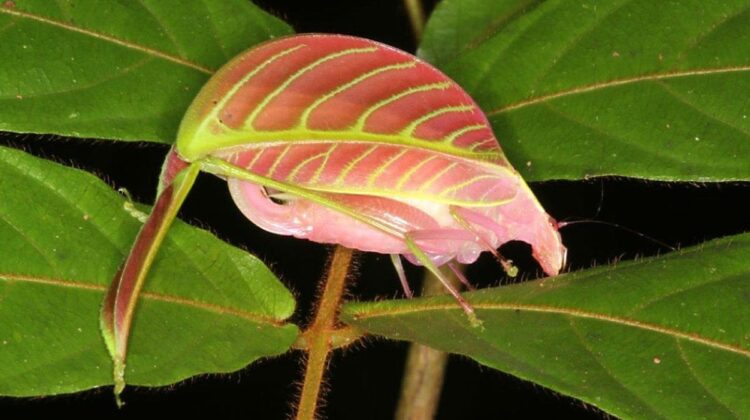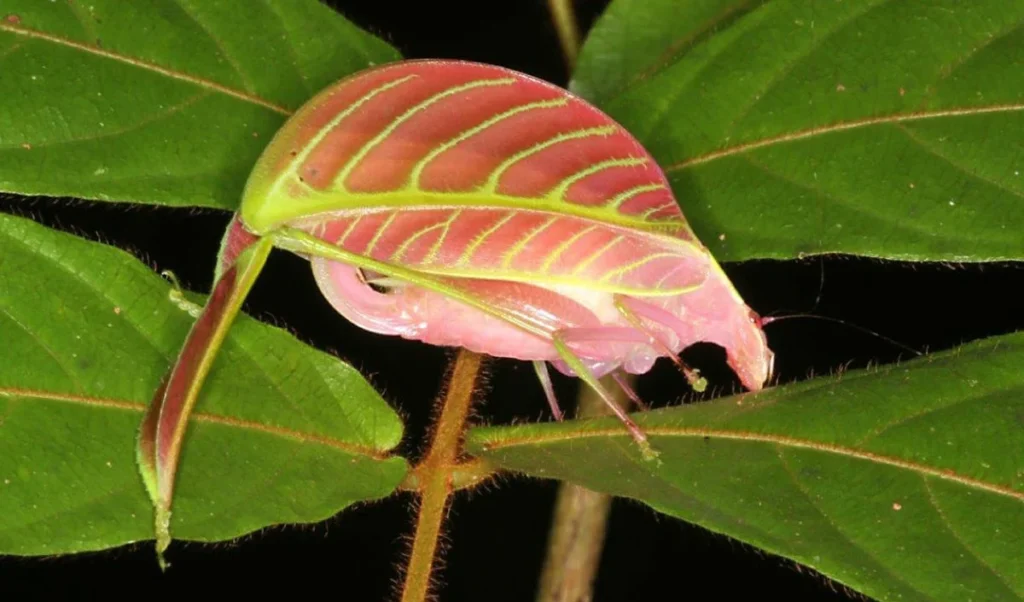
With the holiday season just around the corner, it’s the perfect time to marvel at the unusual katydid that looks like a festive Christmas edition of its regular counterpart. Not only does this peculiar insect resemble a leaf, but its hind legs are so remarkably similar to the real thing that you might find yourself staring at them in awe for an extended period.

Take a closer look at these astonishing hind legs, and you’ll be amazed at their perfection. The intricate detail and uncanny resemblance to actual foliage are truly remarkable. However, there’s an additional layer of peculiarity to these legs—the females are the only ones that display shades of pink and red, leaving scientists puzzled as to the reason behind this gender-specific coloration.
Late last year, researchers announced the discovery of two new species of katydid found in the dense forests of Sabah, a state in Malaysia located on the northern part of Borneo Island. These newfound species belong to the genus Eulophophyllum, which, for nearly a century, had consisted of only one known species—Eulophophyllum thaumasium.
E. thaumasium was so extraordinary that it was named after the ancient Greek word for wonder, “thaumazein,” when it was first discovered on the island of Labuan, about 8 kilometers off the coast of Sabah. Only a single specimen of E. thaumasium had been found until recently, when ongoing expeditions since 1991 finally uncovered more Eulophophyllum species—a significant breakthrough.
Photographer Peter Kirk captured striking images of a brightly colored katydid back in 2013, which were then shown to George Beccaloni from the London Natural History Museum and Sigfrid Ingrisch, an expert on Asian katydids from the Alexander Koenig Research Museum in Germany. As soon as Beccaloni and Ingrisch laid eyes on these images, they knew they had stumbled upon something extraordinary.

Classifying insect species based solely on photographs is a rare practice these days, as the subtle physical differences that distinguish one species from another are often too minuscule to discern in an image. However, the unique features of this Eulophophyllum katydid, such as its distinct wing vein patterns and leaf-like hind legs, made it clear to the researchers that it was an entirely new species—thus, Eulophophyllum kirki was named. Further comparisons of similar images from 1993 to more recent social media posts led to the classification of another new species: E. lobulatum.
One intriguing aspect of these katydids is the stark difference in coloration between males and females. The males sport a uniform green hue, while the females display a predominantly pinkish-red color with vibrant green patterns. What makes this phenomenon even stranger is that the females were not found on vegetation with similar coloring. If they predominantly perch on green leaves, why didn’t they develop green coloration like the males?

In their research paper, the scientists suggest two potential explanations. The first is that these particular females might not possess a strong understanding of camouflage, while the majority of other females in the species might actually be found on red leaves. The second possibility, although less likely, is that the coloration serves a different purpose altogether—it could be a warning signal to potential predators that these females are unpalatable and should not be consumed.
To truly understand the reasons behind this unique coloration, further study and observation of these intriguing creatures are necessary. However, considering that more conspicuous pink katydids from North America thrive despite their distinctive appearance, it seems that katydids can indeed embrace their differences and flourish in their own remarkable way.

Leave a Reply